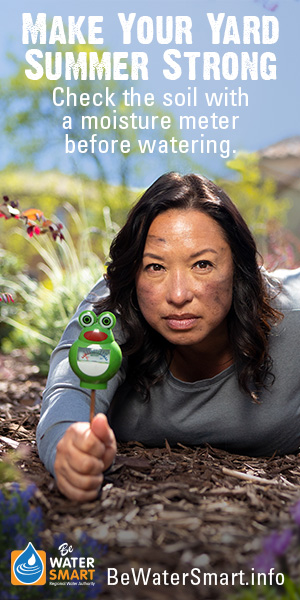Learn what makes a Summer Strong plant and possible signs that plants are suffering. It starts with understanding soil moisture and how to maintain its balance.
By Debbie Arrington
Guest Writer
Do flowers hold their heads high or does everything look droopy? Are leaves fresh and green – or fried and crisp? Are plants thriving – or barely surviving?
Summer in the Sacramento region is a real test of a landscape’s resiliency. The stress of high heat and intense sun with no rain can mean life or death for plants dependent on people for their moisture needs.
Tough enough to handle the hottest days, the plants that look their best are Summer Strong.
Some plants—such as California and Southwest natives—were made for this kind of weather. Once established, they’re naturally water-wise and need less summer irrigation than turf or other traditional landscaping.
An added bonus: Bees, butterflies and birds love these natives. Their flowers not only add color, but life to your summer landscape.
This summer, the Placer County Water Agency teamed with the UCCE Master Gardeners of Placer County to suggest favorite Summer Strong plants for the foothills and valley. Among their picks: De La Mina verbena (a bright purple, low-growing ground cover), Santa Barbara daisy (another low-growing perennial and non-stop bloomer) and the eye-catching and fragrant Cleveland sage (plus several other salvias). Read more about them here: https://www.pcwa.net/smart-water-use/summer-strong.
 All these plants have low water needs and good summer looks, say the master gardeners. Even in August, they need only weekly irrigation—or less. The plants have been thoroughly tested in local gardens as well as the UC Davis’ Arboretum and Public Gardens, which lists these varieties among their top water-wise performers. They’re also widely available, either at local nurseries or plant sales including the arboretum’s fall sales.
All these plants have low water needs and good summer looks, say the master gardeners. Even in August, they need only weekly irrigation—or less. The plants have been thoroughly tested in local gardens as well as the UC Davis’ Arboretum and Public Gardens, which lists these varieties among their top water-wise performers. They’re also widely available, either at local nurseries or plant sales including the arboretum’s fall sales.
The best time to plant these Summer Strong stars? In the fall; that way they have months to put down roots and prepare for next summer.
Any garden can be made Summer Stronger. The key is soil moisture; not too much or too little, but just right.
“We’re fortunate this year to get a lot of rain; there’s still some moisture in the soil,” says Linda Higgins, PCWA Deputy Director of Customer Services. “The top may be dry, but a few centimeters below the surface may be moist.”
How do you know? Look. Use a trowel and dig down a few inches. Try to plunge a 6-inch screwdriver into the soil. Or better yet, use a moisture meter.
“We’re encouraging people to check their soil before they water or turn on the sprinklers,” Higgins says. “Use a soil moisture meter; a lot of water agencies are offering those free of charge or buy one at a local nursery or hardware store. It checks the moisture instantly.”
 When you do water, make sure the moisture actually soaks into the root zone and doesn’t just run off.
When you do water, make sure the moisture actually soaks into the root zone and doesn’t just run off.
“We recommend the cycle and soak method,” Higgins adds. “Run the sprinklers for a short period of time and watch to see if water is running off the property. Let the water soak in, then run the sprinklers again.”
Mulch and organic matter such as compost both help to retain soil moisture while keeping roots cooler and comfortable. Soil microbes like it, too.
“We recommend three to four inches of mulch on your landscape,” Higgins says. “Mulch acts like icing on a cake; it keeps it moist.”
Plants perform best when their soil never dries out completely but is never soggy.
“Even, balanced moisture is important,” Higgins notes. “Too much can be harmful, too. The tricky part: Signs of over-watering are very similar to under-watering.”
Yellowish leaves or dropped foliage, for example, can be signs of too much water as well as not enough.
“Wilting in the afternoon is OK especially for big-leaved plants, but in the morning is a problem,” she says. “But wilting may be caused by too much water instead of too little. Yellow leaves can go either way, too.”
How can a plant get too much water? Usually, it’s due to poor drainage. A plant in a container with a plugged drainage hole could be oversaturated from daily watering. “You can drown the roots,” Higgins says. “That’s why we check the soil moisture.”
 Other signs of suffering: Dry brown leaves or dry patches of turf or ground cover.
Other signs of suffering: Dry brown leaves or dry patches of turf or ground cover.
“It’s so hot right now, things are crispy looking,” Higgins notes. “Grass looks like it’s baked. You’ve got to make sure moisture is getting to the right place—the roots where it’s needed.”
Besides the cycle and soak method, drip irrigation, rotary nozzles and other upgrades also help get water where it’s needed and make your landscape Summer Strong.
“You need to get to know your plants to really know how they’re growing,” Higgins adds. “If you see problems, check your irrigation. Do regular maintenance. Make improvements. Water agencies have rebates for upgrades such as smart controllers. There’s a lot of great information on BeWaterSmart.info.”
Troubleshoot problems with your sprinkler system using Be Water Smart’s Sprinkler Symptom Solver at https://bewatersmart.info/sprinkler-symptom-solver/.
———————————————————————————————————————————-
Debbie Arrington is a longtime home and garden reporter and co-author of the blog Sacramento Digs Gardening: https://sacdigsgardening.californialocal.com/


